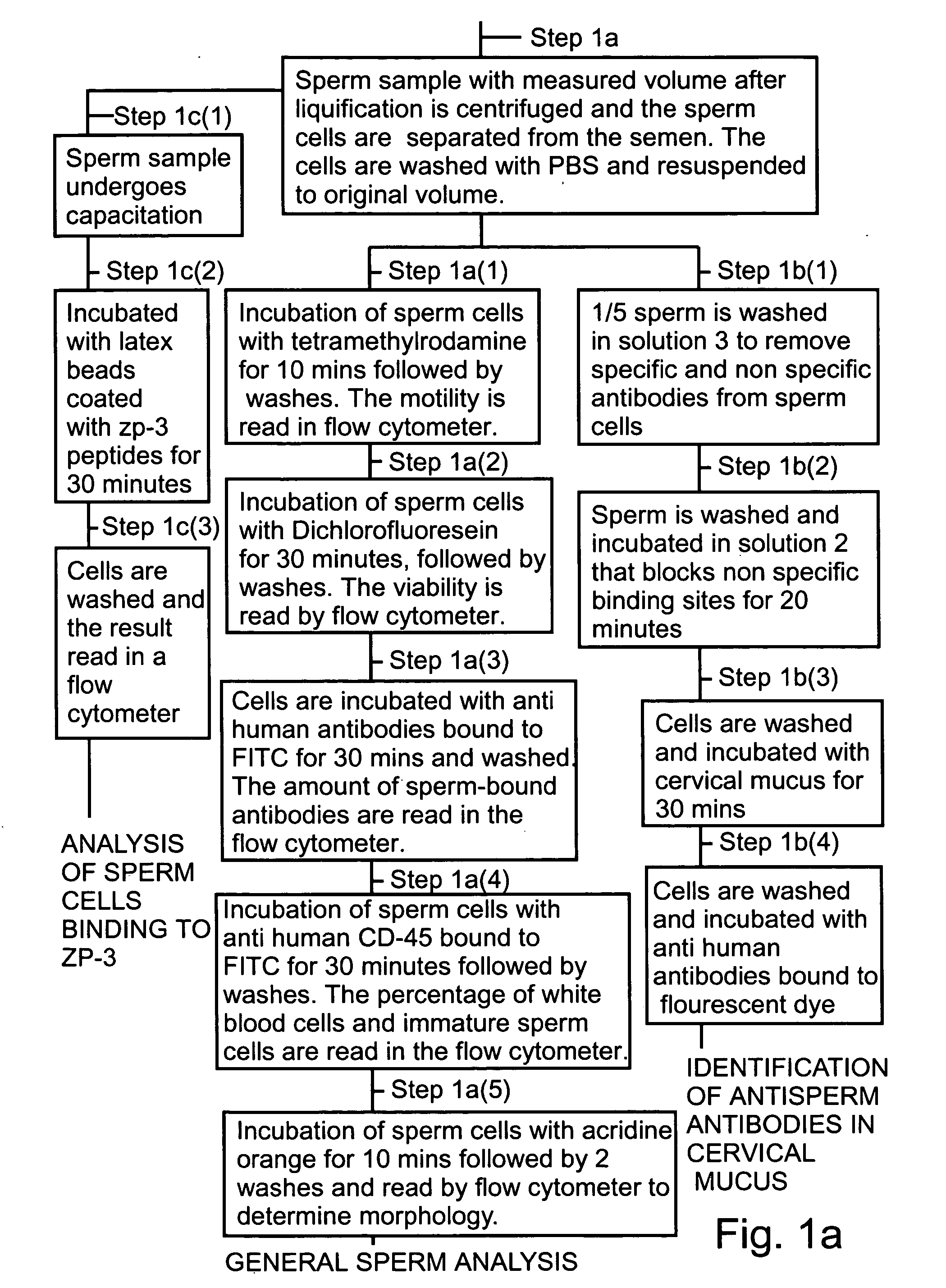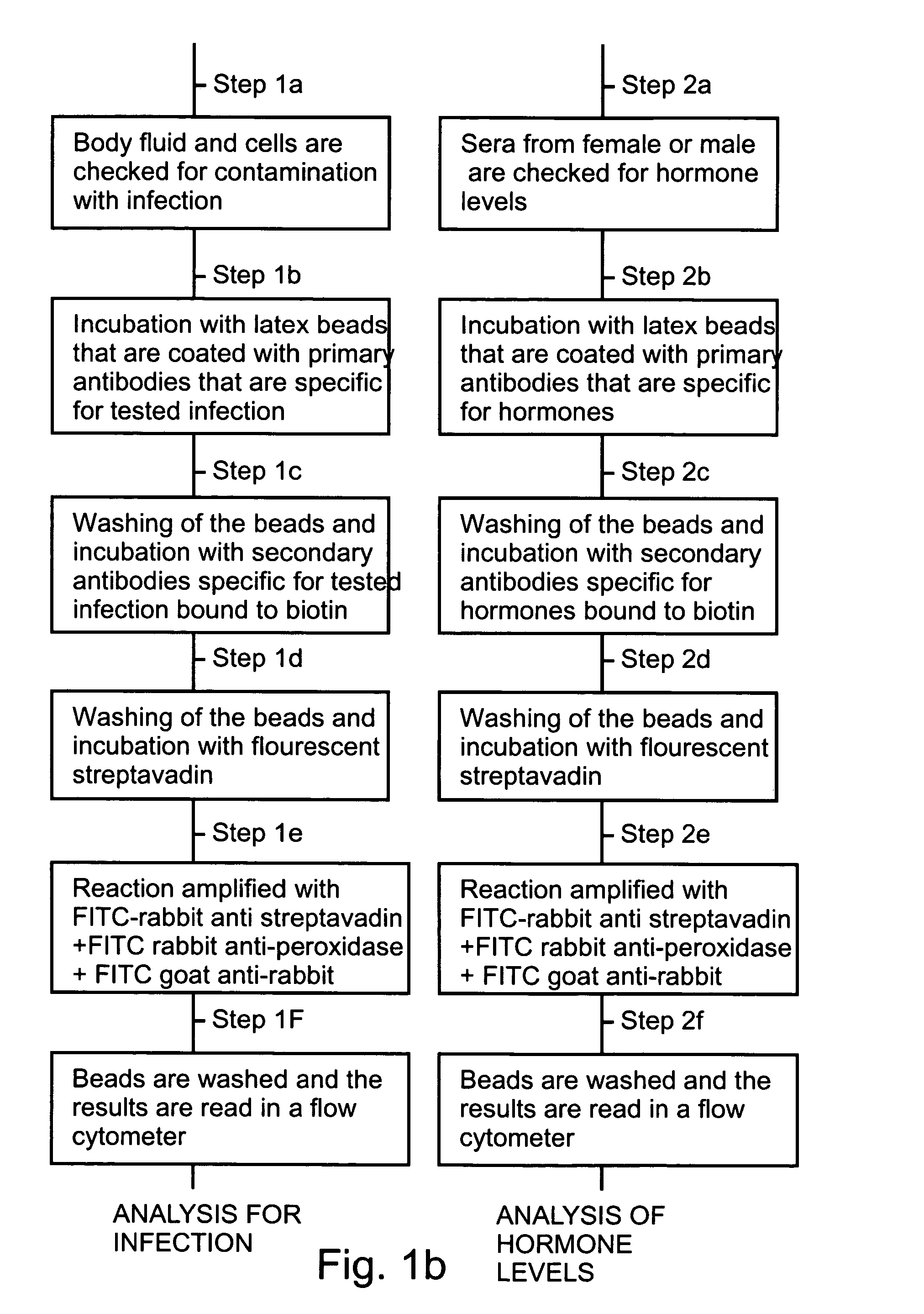Flow cytometer for analysis of general diagnostic factors in cells and body fluids
a flow cytometer and general diagnostic technology, applied in the field of general diagnostic factors analysis of cells and body fluids using flow cytometers, can solve the problems of inability to estimate linearity or velocity distribution functions, inability to identify various sperm precursor cells and somatic cells sometimes present in semen, and the development of tedious multiple exposure time-lapse photography methods, etc., to increase cell motility and increase the success of ivf treatmen
- Summary
- Abstract
- Description
- Claims
- Application Information
AI Technical Summary
Benefits of technology
Problems solved by technology
Method used
Image
Examples
example 1
Specific Example of General Analysis of Sperm Sample
General analysis of the sperm sample specifically measures cell count, percentage and number of motile cells, normal morphology, number and percentage of white blood cells and number and percentage of dead cells. A number of tubes are used in the analysis and each kit is done in a different tube.
The volume of the sample was recorded. The cells were then pelleted and washed twice with PBS (phosphate buffer saline). The cells were then resuspended to the original volume with PBS. Preparation of the sample took approximately 1 hour.
Six tubes suitable for reading in the flow cytometer were taken, A, B, C, D E and F. Sample (100 μl) was put in each of five of the tubes A-E. In tube F 50 μl of diluted sample (1:20) was placed. Tube A was the control. Tube B was used to measure cell motility. Tetramethylrhodamine (TMR, 0.25 μM) was added to the sample (100 μl) and incubated for 10 minutes at room temperature. The sample was then was...
example 2
Detection of Antisperm Antibodies in Cervical Mucus
The test for identification of antisperm antibodies in cervical mucus is highly specific. A suitable volume which for a typical sample size is 1 ml of a neutral washing solution such as 0.15 M Hepes at pH 7.2 is added to the sperm cell pellet. The cells are resuspended and a suitable volume of treated solution such as 1 ml of 0.2 M Hepes at pH 3-5 is added. The cells are incubated for an appropriate amount of time, which in the present example is three minutes. A suitable amount of stop solution, which for a typical sample size is 2 ml of a basic solution such as 0.1 M Hepes at pH 11 is added and the cells are centrifuged.
The pellet is resuspended with an appropriate volume of a suitable blocking solution such as 1 ml of 0.15 M Hepes with 5% goat serum and incubated for a suitable amount of time, which in the present example is fifteen minutes at room temperature. The cervical mucus is treated prior to the assay. Treatment invol...
example 3
Identification of Chlamydia Trachomatis Infection in Seminal Plasma and Cervical Mucus
This experiment is performed to identify infection in seminal plasma and cervical mucus. The cervical mucus or seminal plasma is treated prior to the assay. This is done by adding a suitable reagent to liquefy the cervical mucus or seminal plasma such as bromelain 100 μg / ml in 0.15 M Hepes at pH 7.2. A suitable volume, such as one fifth of the sample volume is added and incubated under suitable conditions, such as thirty minutes at 37° C.
Antibodies, specific to Chlamydia trachomatis, are coupled onto beads. These beads are added to the clinical sample and incubated under suitable conditions, for example for thirty minutes at 37° C. The beads are centrifuged and the pellet resuspended with a suitable volume which for a typical sample size is 2 ml of a neutral washing solution such as 0.15 M Hepes at pH 7.2. This is repeated twice and the beads are resuspended in a suitable volume which for a typ...
PUM
 Login to View More
Login to View More Abstract
Description
Claims
Application Information
 Login to View More
Login to View More - R&D
- Intellectual Property
- Life Sciences
- Materials
- Tech Scout
- Unparalleled Data Quality
- Higher Quality Content
- 60% Fewer Hallucinations
Browse by: Latest US Patents, China's latest patents, Technical Efficacy Thesaurus, Application Domain, Technology Topic, Popular Technical Reports.
© 2025 PatSnap. All rights reserved.Legal|Privacy policy|Modern Slavery Act Transparency Statement|Sitemap|About US| Contact US: help@patsnap.com



